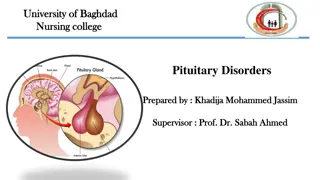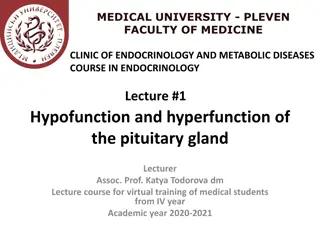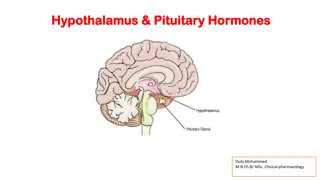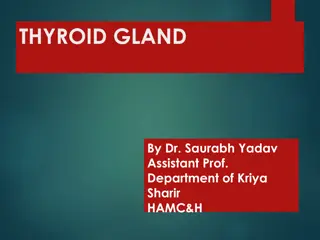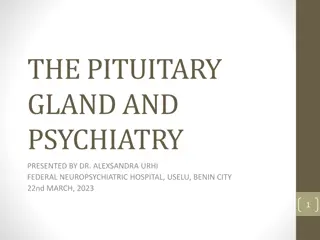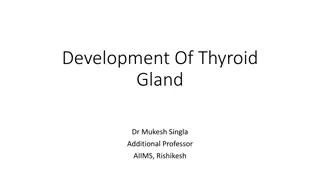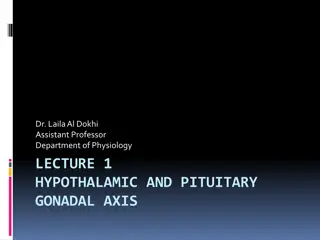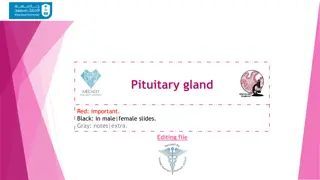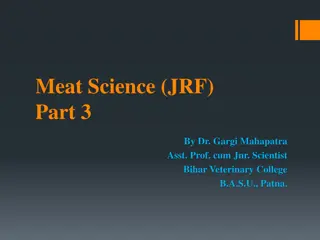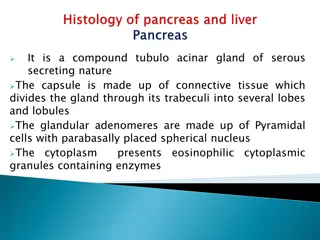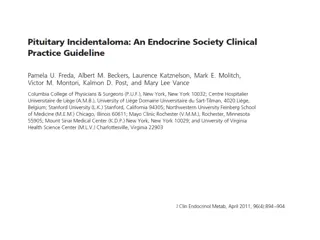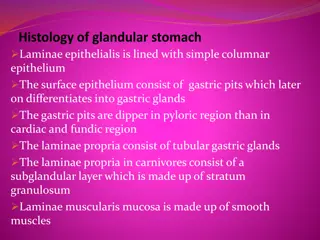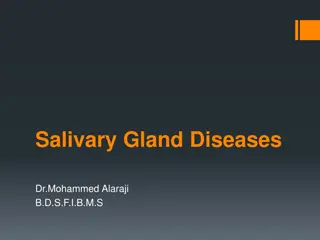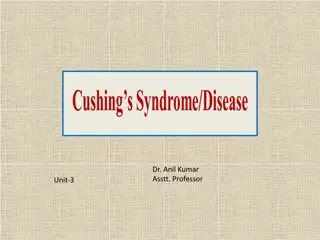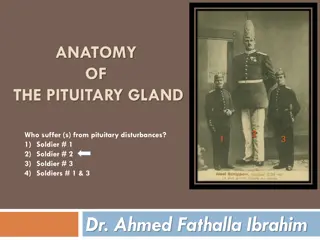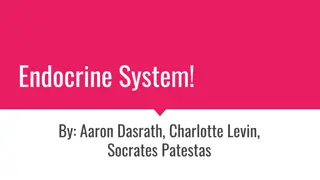Overview of Pituitary Gland: Structure, Function, and Relationships
The pituitary gland, also known as the hypophysis, is an endocrine gland located at the base of the brain. It is divided into two main parts: the adenohypophysis and the neurohypophysis. The gland plays a crucial role in hormone regulation and is closely related to neighboring structures such as the optic chiasm and cavernous sinus. It is essential for various bodily functions and is supplied by specific arterial branches while drained by venous vessels. Understanding its anatomy and relationships is key to comprehending its significance in the human body.
Download Presentation

Please find below an Image/Link to download the presentation.
The content on the website is provided AS IS for your information and personal use only. It may not be sold, licensed, or shared on other websites without obtaining consent from the author. Download presentation by click this link. If you encounter any issues during the download, it is possible that the publisher has removed the file from their server.
E N D
Presentation Transcript
PITUTARY GLAND DR.MANJULA.VASTRAD ASST.PROF DEPT OF SHAREERA RACHANA SMVVS RKM AMC VIJAYAPUR Email : manjula.prasad2010@gmail.com
DEFINITION It is an endocrine gland of a neuroglandular body which hangs from the floor of 3rdventricle by a stalk called infundibulum. COLOUR Reddish grey SHAPE Ovoid MEASUREMENTS Transversely 12mm Anteroposteriorly 8mm WEIGHT 500mg
SITUATION Situated in hypophyseal fossa of the sella turcica in the body of sphenoid bone covered by diaphragma sellae of duramater. COVERINGS Covered by pia mater and arachnoid mater which is adherent to capsule of the gland. Pia mater and arachnoid mater are fused
PARTS / LOBES Consists of two parts Adenohypophysis/ Anterior lobe Further subdivided as - Pars anterior / distalis Pars intermedia Pars tuberalis Neurohypophysis / Posterior lobe Further subdivided as - Median eminence Infundibular stem Pars nervosa
RELATIONS Anteriorly anterior intercavernous sinus Posteriorly posterior intercavernous sinus Superiorly optic chaisma anterior communicating artery third ventricle Inferiorly sphenoidal air sinus Laterally cavernous sinus with structures passing through it a) Internal carotid artery with sympathetic plexus b) Abducent, occulomotor, trochlear, opthalmic and maxillary nerves
ARTERIAL SUPPLY Supplied by two sets of arteries Superior hypophyseal arteries supplying median eminence, pitutary stalk and the adenohyposis Inferior hypophyseal arteries supplies the infundibular process and infundibular stalk
VENOUS DRAINAGE Blood is drained by the short veins , into the cavernous sinus from adenohypophysis And via the hypothalamo-hypophyseal portal system from neurohyposis
DEVELOPMENT Anterior lobe developed from ectoderm , from the roof of stomodium as an upgrowth dilation called Rathke s pouch. Posterior lobe developed as a diverticulum grows downwards from the floor of diencephalon.
HARMONES The pituitary is an important gland in the body and it is often referred to as the 'master gland', because it controls several of the other hormone glands The anterior pituitary synthesizes and secretes hormones. All releasing hormones (-RH) referred to, can also be referred to as releasing factors (-RF). Somatotrophins: Human growth hormone (HGH), also referred to as 'growth hormone' (GH), and also as somatotropin, is released under the influence of hypothalamic growth hormone- releasing hormone (GHRH).
Thyrotrophins: Thyroid-stimulating hormone (TSH), is released under the influence of hypothalamic thyrotropin-releasing hormone (TRH) and is inhibited by somatostatin. Corticotropins: Adrenocorticotropic hormone (ACTH), and Beta- endorphin are released under the influence of hypothalamic corticotropin-releasing hormone (CRH).
Lactotrophins: Prolactin (PRL), also known as 'Luteotropic' hormone (LTH), whose release is inconsistently stimulated by hypothalamic TRH, oxytocin, vasopressin, vasoactive intestinal peptide, angiotensin II, and neurotensin, and inhibited by hypothalamic dopamine. Gonadotropins: Luteinizing hormone (also referred to as 'Lutropin' or 'LH'). Follicle-stimulating hormone (FSH), both released under influence of Gonadotropin-Releasing Hormone (GnRH)
These hormones are released from the anterior pituitary under the influence of the hypothalamus. Hypothalamic hormones are secreted to the anterior lobe by way of a special capillary system, called the hypothalamic-hypophysial portal system.
Intermediate The intermediate lobe synthesizes and secretes the following important endocrine hormone: Melanocyte stimulating hormone (MSH). This is also produced in the anterior lobe.[6]When produced in the intermediate lobe, MSHs are sometimes called "intermedins".
Posterior The posterior pituitary stores and secretes (not synthesize) the following important endocrine hormones: Antidiuretic hormone (ADH, also known as vasopressin and arginine vasopressin AVP), the majority of which is released from the supraoptic nucleus in the hypothalamus. Oxytocin, most of which is released from the paraventricular nucleus in the hypothalamus. Oxytocin is one of the few hormones to create a positive feedback loop. For example, uterine contractions stimulate the release of oxytocin from the posterior pituitary, which, in turn, increases uterine contractions. This positive feedback loop continues throughout labour.
FUNCTIONS Hormones secreted from the pituitary gland help control the following body processes: Growth Blood pressure Some aspects of pregnancy and childbirth including stimulation of uterine contractions during childbirth Breast milk production Sex organ functions in both males and females Thyroid gland function The conversion of food into energy (metabolism) Water and osmolarity regulation in the body Water balance via the control of reabsorption of water by the kidneys Temperature regulation Pain relief
All of the functions of the pituitary gland can be adversely affected by an over or under production of associated hormones.
THANK YOU

 undefined
undefined









